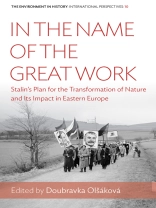Beginning in 1948, the Soviet Union launched a series of wildly ambitious projects to implement Joseph Stalin’s vision of a total “transformation of nature.” Intended to increase agricultural yields dramatically, this utopian impulse quickly spread to the newly communist states of Eastern Europe, captivating political elites and war-fatigued publics alike. By the time of Stalin’s death, however, these attempts at “transformation”—which relied upon ideologically corrupted and pseudoscientific theories—had proven a spectacular failure. This richly detailed volume follows the history of such projects in three communist states—Poland, Hungary, and Czechoslovakia—and explores their varied, but largely disastrous, consequences.
Table of Content
Acknowledgments
List of Tables
Abbreviations
Introduction: The Stalin Plan for the Transformation of Nature and the East European Experience
Paul Josephson
Chapter 1. Kafkaesque Paradigms: The Stalinist Plan for the Transformation of Nature in Czechoslovakia
Doubravka Olšáková and Arnošt Štanzel
Chapter 2. Untamed Seedlings: Hungary and Stalin Plan for the Transformation of Nature
Zsuzsanna Borvendég and Mária Palasik
Chapter 3. The Conspiracy of Silence: Stalinist Plan for the Transformation of Nature in Poland
Beata Wysokińska
Conclusion: Environmental History, East-European Societies and Totalitarian Regimes
Doubravka Olšáková
Name Index
Local Index
Subject Index
About the author
Doubravka Olšáková is a senior researcher at the Institute for Contemporary History at the Academy of Sciences of the Czech Republic, where she leads a working group on environmental history. Her publications include the book Science Goes to the People! (2014), which examines mass indoctrination and the dissemination of science in communist Czechoslovakia.












